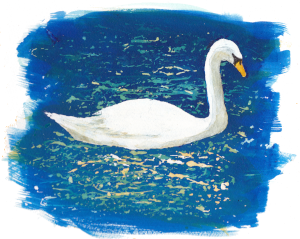

Why is there an image of a swan at the top of this web site?
The first part of the answer is easy: the design needed some sort of image so it’s not purely words. But what image?
While I was wondering what might suit, my eye was caught by a swan, so I took a photograph. As I did that, I was aware that the lighting wasn’t ideal and the angle wasn’t ideal. There was probably a large gap between the swan catching my eye and how the photo might appear. Taking the photo made sense, but it seemed more like the start of a journey than its ending.
A few days later my eye was caught by some marks on a wall. They were almost certainly random. I thought I saw the outline of a swan in them, though I suspect others would see other things in them. It was as if something was causing swans to come to mind.
Wondering about this, a memory of a traditional-style Chinese painting in a friend’s flat in Singapore came to mind. I was sure it included a swan. I checked a photograph. No swan. Why had I “remembered” something that wasn’t there?
My sense was that there was something going on that was bring swans to mind in relation to this web site. I started to paint it, wondering what would happen. It changed a little in the course of being painted. It’s “completed” — in as much as I’ve used the image on this site, but I wonder whether I need to paint it again. It may be a step on a journey rather than the loses something, as if the conscious mind has taken control at the expense of what was trying to be said.
Maybe the colours aren’t right. They aren’t what was in the photo. The shape is what was in the photo, but maybe it isn’t “right”. Sometimes a faithful image — like the photo I took — accurately captures what came through the camera lens, but misses something of what one was “seeing”.
Perhaps the painting is right for now, and will need to be replaced in a little while. Perhaps it will feel right for a longer time.
Therapy is a gradual process.
Sometimes a dream, or a daydream, or something that catches the eye leads to an insight that is life-changing. Sometimes it’s just “for today”. Often the difference only becomes clear in hindsight. There’s something about attending to what is going on in the here-and-now and letting that enable change. Sometimes the “ah-ha” moment in therapy is when something that seemed obvious turns out not to be. The assumption is that what’s going on in the unconscious is a healing process, and can be helped by attending to what emerges from it.
In the days when ocean liners would be tied to a quay by many ropes, Freud made a parallel between a psychoanalytic approach to therapy and the departure of an ocean liner: many ropes have to be untied before the liner starts to move.
Therapy is a space where people can take notice of what’s going on for them, helped by the presence of a therapist. Jung talks of the therapist attending to their own inner work as something that helps the person in therapy attend to theirs. It would get in the way of people coming to this web site looking for psychoanalytic psychotherapy if I said more about what might — or might not — be going on in my unconscious that sent me in the direction of swans while creating this site. There is an invitation in therapy to attend, and to see what that attending enables.